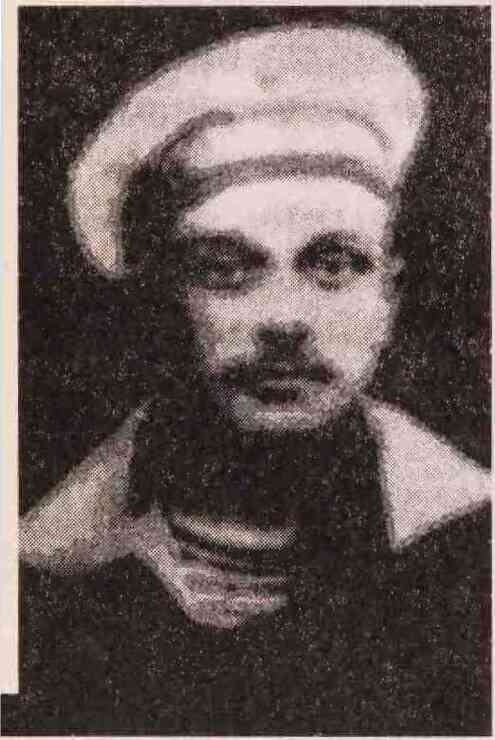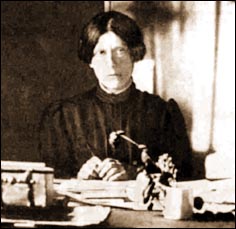|
Boris Donskoy
Boris Mikhailovich Donskoy (russian: Борис Михайлович Донской; 1894 – 10 August 1918) was a Russian Empire terrorist-revolutionary. He was a member of the Left Socialist-Revolutionary party as SR-maximalist. Donskoy became widely known for his assassination of German Field Marshal and military governor of Ukraine Hermann von Eichhorn in summer of 1918. Biography Early life Boris was born in a village of Gladkie Vyselki, Mikhailovsk uyezd (county), Ryazan Governorate in a peasant family of Russian Orthodox Old Believers. After finishing at village school Donskoy went to Saint Petersburg to seek employment at age 15. In 1915, during the First World War, he was mobilized into the Imperial Russian Army and Donskoy was placed onto a transport ship "Asia" in the Baltic Fleet. Revolutionary Activities In 1916 Donskoy joined the Left Socialist-Revolutionary Party and soon after that he was arrested for organizing a hunger strike and anti-government propaganda. Righ ... [...More Info...] [...Related Items...] OR: [Wikipedia] [Google] [Baidu] |
July Days
The July Days (russian: Июльские дни) were a period of unrest in Petrograd, Russia, between . It was characterised by spontaneous armed demonstrations by soldiers, sailors, and industrial workers engaged against the Russian Provisional Government. The demonstrations were angrier and more violent than those during the February Revolution months earlier. The Provisional Government blamed the Bolsheviks for the violence brought about by the July Days and in a subsequent crackdown on the Bolshevik Party, the party was dispersed, many of the leadership arrested. Vladimir Lenin fled to Finland, while Leon Trotsky was among those arrested. The outcome of the July Days represented a temporary decline in the growth of Bolshevik power and influence in the period before the October Revolution. Background ''Note: Dates given in this article reference the Julian Calendar, which was used in Russia until .'' Growing support for the Bolshevik Party In April 1917, Lenin ga ... [...More Info...] [...Related Items...] OR: [Wikipedia] [Google] [Baidu] |
Left Socialist Revolutionaries
The Party of Left Socialist-Revolutionaries (russian: Партия левых социалистов-революционеров-интернационалистов) was a revolutionary socialist political party formed during the Russian Revolution. In 1917, the Socialist Revolutionary Party split between those who supported the Russian Provisional Government, established after the February Revolution and those who supported the Bolsheviks, who favoured the overthrow of the Provisional Government and the placing of political power in the hands of the Congress of Soviets. Those that continued to support the Provisional Government became known as the Right SRs while those who aligned with the Bolsheviks became known as the Left Socialist-Revolutionaries or Left SRs. After the October Revolution, the Left SRs formed a coalition government with the Bolsheviks from November 1917 to July 1918, but resigned its position in government after the signing of the Treaty of Brest-Litovsk. T ... [...More Info...] [...Related Items...] OR: [Wikipedia] [Google] [Baidu] |
Hetman Of Ukraine
Hetman of Ukraine ( uk, Гетьман України) is a former historic government office and political institution of Ukraine that is equivalent to a head of state or a monarch. Brief history As a head of state the position was established at first by Bohdan Khmelnytsky during the Cossack Hetmanate in the mid-17th century. During that period the office was electoral. Later in the late 18th century it was successfully liquidated by the Russian government during the expansion of the Russian territory towards the Black Sea coast. The position and title was reestablished in 1918 by the Ukrainian General Pavlo Skoropadsky Pavlo Petrovych Skoropadskyi ( uk, Павло Петрович Скоропадський, Pavlo Petrovych Skoropadskyi; – 26 April 1945) was a Ukrainian aristocrat, military and state leader, decorated Imperial Russian Army and Ukrainian Arm ...i, a descendant of the former Hetman of Zaporizhian Host Ivan Skoropadskyi. The Law on the Provisional Sta ... [...More Info...] [...Related Items...] OR: [Wikipedia] [Google] [Baidu] |
Boris Donskoy(dead)
Boris Mikhailovich Donskoy (russian: Борис Михайлович Донской; 1894 – 10 August 1918) was a Russian Empire terrorist-revolutionary. He was a member of the Left Socialist-Revolutionary party as SR-maximalist. Donskoy became widely known for his assassination of German Field Marshal and military governor of Ukraine Hermann von Eichhorn in summer of 1918. Biography Early life Boris was born in a village of Gladkie Vyselki, Mikhailovsk uyezd (county), Ryazan Governorate in a peasant family of Russian Orthodox Old Believers. After finishing at village school Donskoy went to Saint Petersburg to seek employment at age 15. In 1915, during the First World War, he was mobilized into the Imperial Russian Army and Donskoy was placed onto a transport ship "Asia" in the Baltic Fleet. Revolutionary Activities In 1916 Donskoy joined the Left Socialist-Revolutionary Party and soon after that he was arrested for organizing a hunger strike and anti-government propaganda. Ri ... [...More Info...] [...Related Items...] OR: [Wikipedia] [Google] [Baidu] |
Kyiv
Kyiv, also spelled Kiev, is the capital and most populous city of Ukraine. It is in north-central Ukraine along the Dnieper, Dnieper River. As of 1 January 2021, its population was 2,962,180, making Kyiv the List of European cities by population within city limits, seventh-most populous city in Europe. Kyiv is an important industrial, scientific, educational, and cultural center in Eastern Europe. It is home to many High tech, high-tech industries, higher education institutions, and historical landmarks. The city has an extensive system of Transport in Kyiv, public transport and infrastructure, including the Kyiv Metro. The city's name is said to derive from the name of Kyi, one of its four legendary founders. During History of Kyiv, its history, Kyiv, one of the oldest cities in Eastern Europe, passed through several stages of prominence and obscurity. The city probably existed as a commercial center as early as the 5th century. A Slavs, Slavic settlement on the great trade ... [...More Info...] [...Related Items...] OR: [Wikipedia] [Google] [Baidu] |
Imperial Germany
The German Empire (),Herbert Tuttle wrote in September 1881 that the term "Reich" does not literally connote an empire as has been commonly assumed by English-speaking people. The term literally denotes an empire – particularly a hereditary empire led by an emperor, although has been used in German to denote the Roman Empire because it had a weak hereditary tradition. In the case of the German Empire, the official name was , which is properly translated as "German Empire" because the official position of head of state in the constitution of the German Empire was officially a "presidency" of a confederation of German states led by the King of Prussia who would assume "the title of German Emperor" as referring to the German people, but was not emperor of Germany as in an emperor of a state. –The German Empire" ''Harper's New Monthly Magazine''. vol. 63, issue 376, pp. 591–603; here p. 593. also referred to as Imperial Germany, the Second Reich, as well as simply Germany, ... [...More Info...] [...Related Items...] OR: [Wikipedia] [Google] [Baidu] |
Ukraine
Ukraine ( uk, Україна, Ukraïna, ) is a country in Eastern Europe. It is the second-largest European country after Russia, which it borders to the east and northeast. Ukraine covers approximately . Prior to the ongoing Russian invasion, it was the eighth-most populous country in Europe, with a population of around 41 million people. It is also bordered by Belarus to the north; by Poland, Slovakia, and Hungary to the west; and by Romania and Moldova to the southwest; with a coastline along the Black Sea and the Sea of Azov to the south and southeast. Kyiv is the nation's capital and largest city. Ukraine's state language is Ukrainian; Russian is also widely spoken, especially in the east and south. During the Middle Ages, Ukraine was the site of early Slavic expansion and the area later became a key centre of East Slavic culture under the state of Kievan Rus', which emerged in the 9th century. The state eventually disintegrated into rival regional po ... [...More Info...] [...Related Items...] OR: [Wikipedia] [Google] [Baidu] |
Irina Kakhovskaya
Irina Konstantinovna Kakhovskaya (15 August 1887, Tarashcha, Kiev Governorate – 1 March 1960, Maloyaroslavets, Kaluga Oblast) was a Russian revolutionary, a representative of the Left Socialist-Revolutionaries, organizer of the assassination of the commander of the occupation forces in Ukraine, Field Marshal Hermann von Eichhorn in 1918, grandniece of the Decembrist Pyotr Kakhovsky. Biography She was born into the family of a land surveyor and a national teacher. From 28 August 1897 to 25 May 1903, she studied at the Mariinsky Institute for Orphans of Noble Birth in Saint Petersburg, from which she graduated with a silver medal. Then she entered the historical and philological department of the Women's Pedagogical Institute. Since 1905, she was carried away by revolutionary ideas after she heard the speech of Maxim Gorky. Thanks to her acquaintance with Alexandra Kollontai, for some time she supported the ideas of social democracy and briefly sided with the Bolsheviks in Saint Pe ... [...More Info...] [...Related Items...] OR: [Wikipedia] [Google] [Baidu] |
Pulkovo Heights
Pulkovo Heights () is a chain of hills located to the south of Saint Petersburg. They run to the south-west in the direction of the Izhora Plateau and have an altitude of up to 73 meters. In Neolithic times (about 75005000 years ago) Pulkovo heights were Littorina Sea coast. Its bottom is a modern Neva Lowland with stretching on her St. Petersburg. The ancient sea gradually retreated and took the place of the current Baltic Sea. Apparently, the place abounded with impassable forests and swamps. Thick forest covered the Pulkovo heights, but it was gradually cut down. In the 18th century, located at the foot of Pulkovo village of Gallerovo, Tolmachevo, Pesky, Lower and Upper Koyerovo, Kamen, Kiskino, Glinyanaya Gora, a neighborhood on the site of Pulkovo – Pulkovo village, founded in 1714 at the Pulkovo Manor. A road ran from Pulkovo Koporye in Ladoga. On 12 November 1917, during the October Revolution, Alexander Kerensky and Pyotr Krasnov, commanding 700 Cossacks of the 3rd Cava ... [...More Info...] [...Related Items...] OR: [Wikipedia] [Google] [Baidu] |
Fort Ino
Fort Ino or Fort Nikolaevsky (russian: форт «Ино» or форт Николаевский) is an abandoned early 20th-century Russian coastal fortification situated on the northern shore of Neva Bay in the Gulf of Finland. The fort is close to the present-day settlement Privetninskoye (Former name was Ino before 1946) of Vyborgsky District of Leningrad Oblast, opposite the Krasnaya Gorka fort on the southern shore. Fort Ino is still under Russian control. The ruins of the fortress, with an extensive system of tunnels, are now abandoned and are partially accessible to the public. Early history Fort Ino was constructed in 1909-1916 on Cape Inoniemi on the Karelian Isthmus, within the borders of Viipuri Province of the autonomous Grand Duchy of Finland. It was intended to protect the capital city of Petrograd (Saint Petersburg) and the naval base at Kronstadt, and was served by a railroad and a harbor. As Finland had become independent, on March 1, 1918, during the Finnish Civi ... [...More Info...] [...Related Items...] OR: [Wikipedia] [Google] [Baidu] |


.jpg)